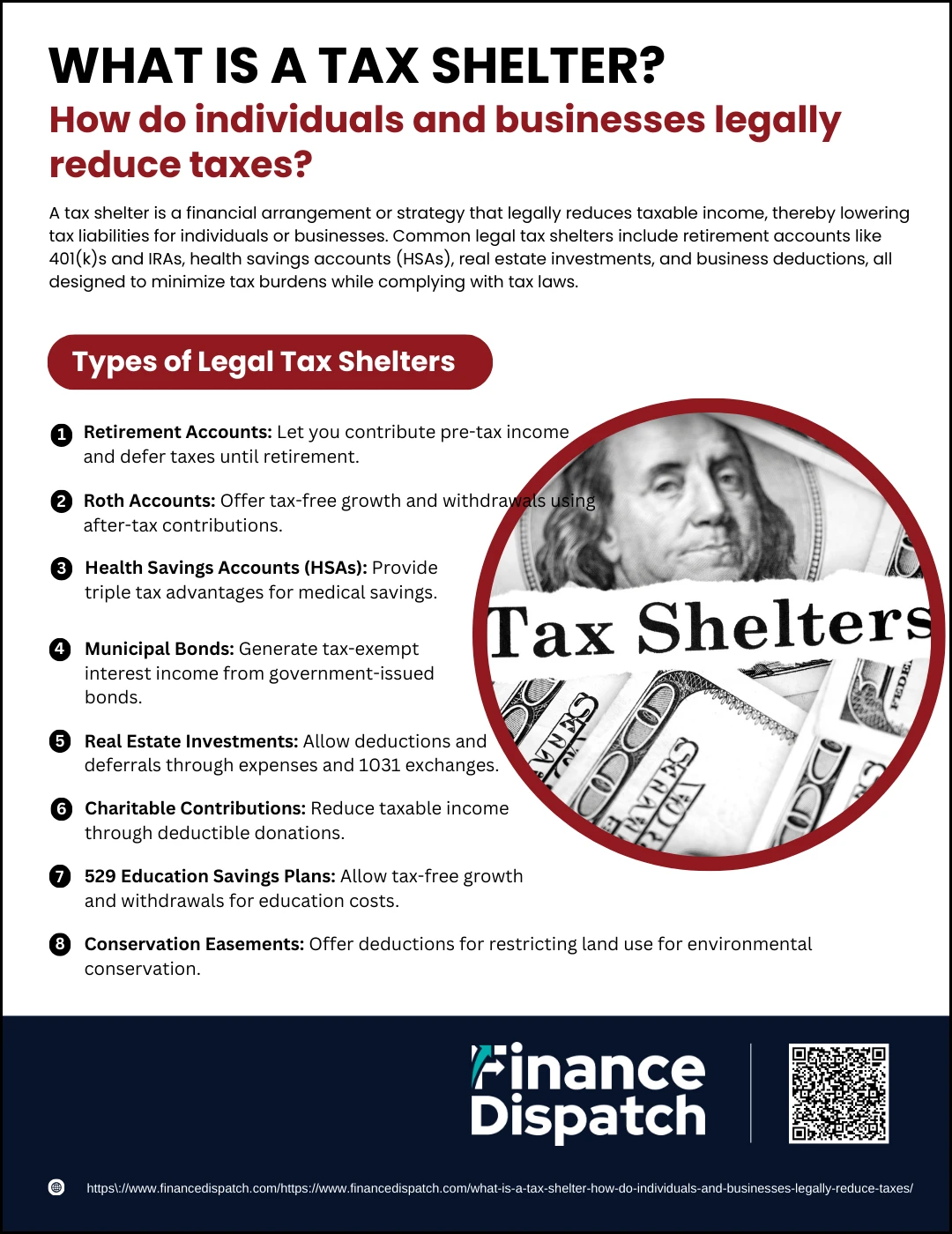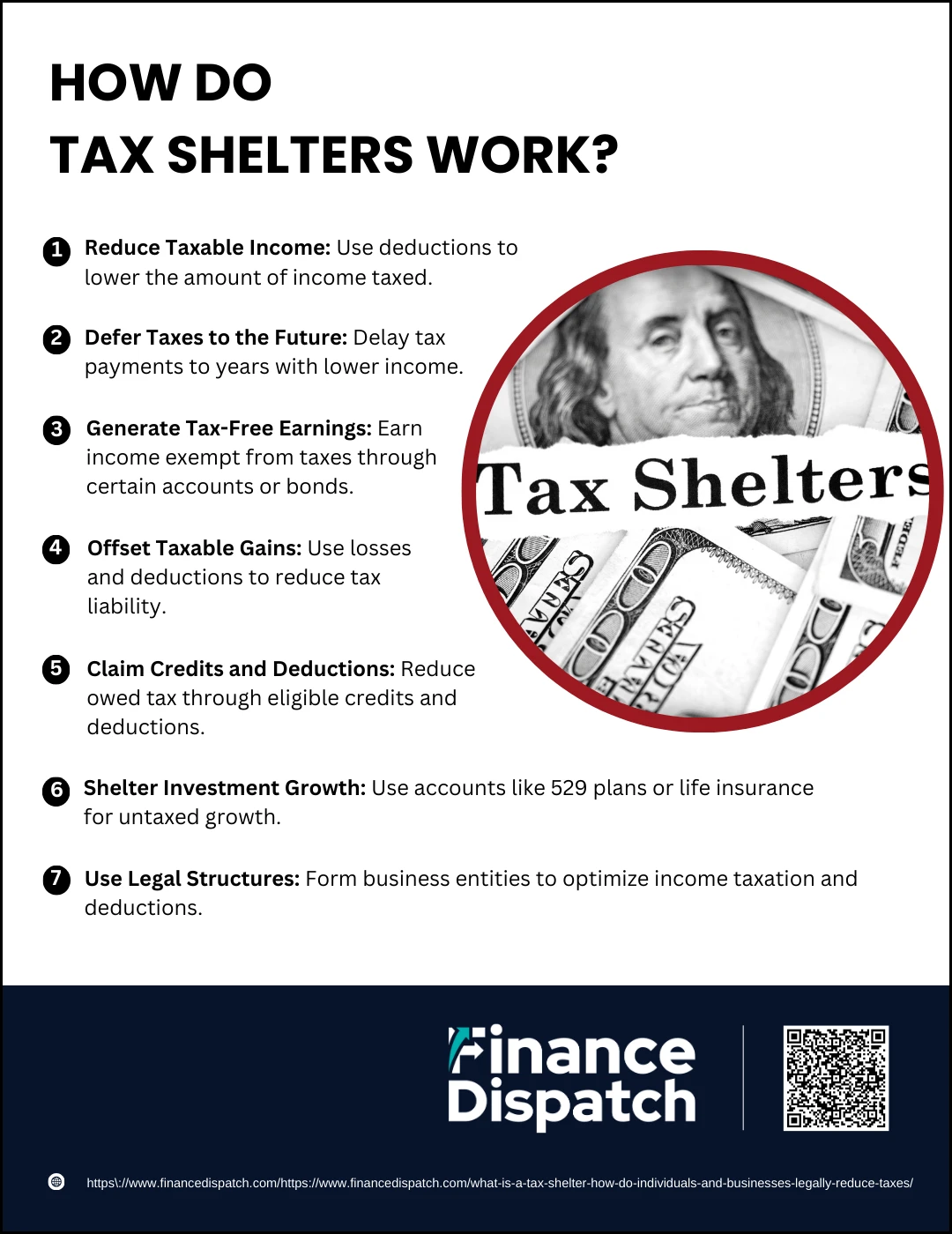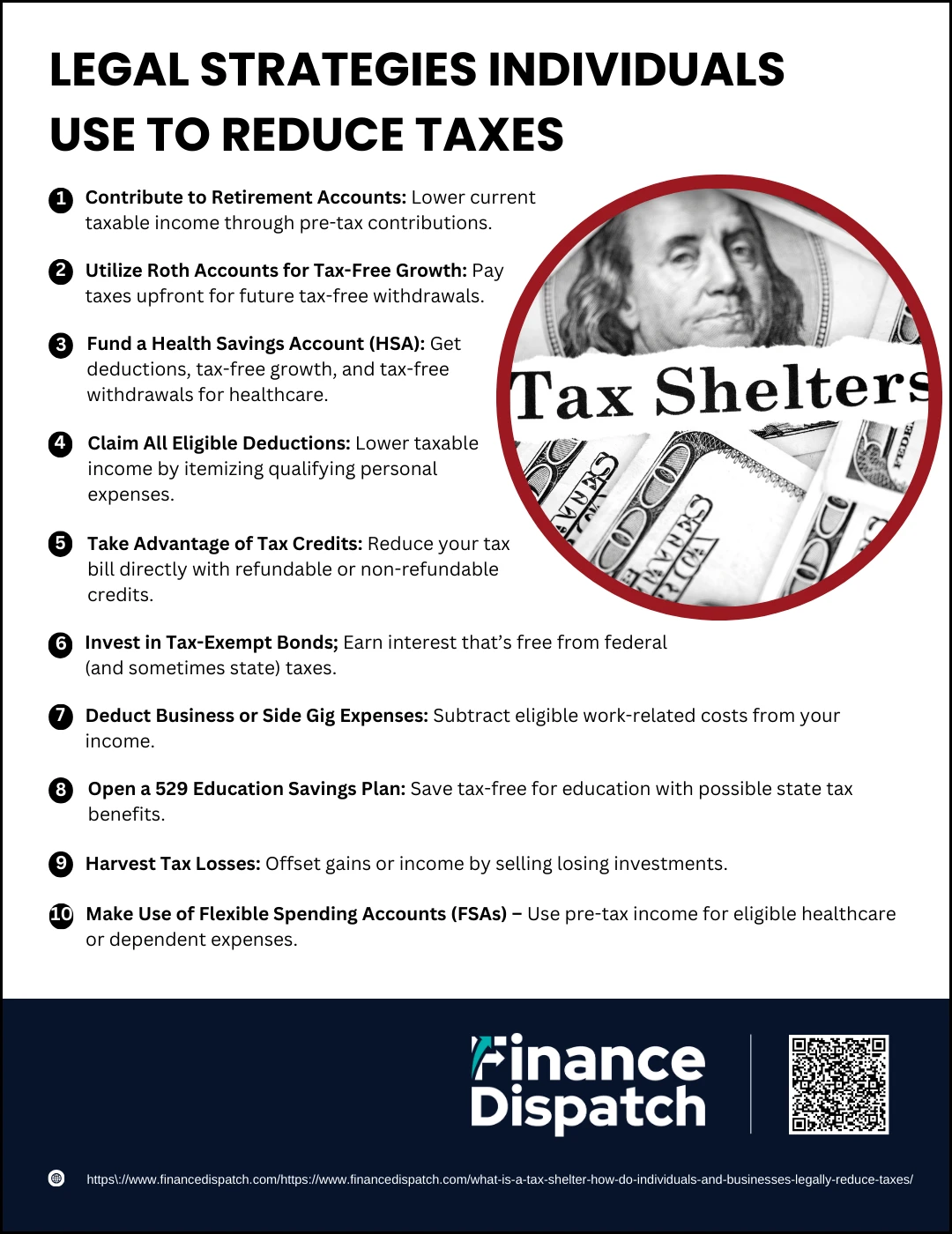A tax shelter is often misunderstood as a tool reserved for the wealthy or associated with shady offshore accounts. In reality, it refers to any legal method that allows individuals or businesses to reduce or defer their tax liabilities by taking advantage of deductions, credits, or specific investment vehicles. From employer-sponsored 401(k) plans to real estate depreciation and charitable contributions, tax shelters are built into the tax code to incentivize savings, investment, and socially beneficial behavior. This article explores what tax shelters are, how they work, and how both individuals and companies can use them to legally lower their tax burden.
What is a Tax Shelter?
A tax shelter is a financial arrangement, strategy, or investment designed to legally reduce taxable income, thereby lowering the amount of taxes owed to the government. These shelters can take many forms, including retirement accounts like 401(k)s and IRAs, tax-exempt municipal bonds, real estate investments, and charitable contributions. While the term “tax shelter” sometimes carries a negative connotation, particularly when associated with aggressive or abusive tactics, many tax shelters are completely legal and encouraged by tax laws to promote beneficial economic behavior such as saving for retirement or supporting public causes. The key distinction lies in their compliance with IRS rules and the intent behind their use.
 Types of Legal Tax Shelters
Types of Legal Tax Shelters
Legal tax shelters are financial tools and strategies specifically allowed under tax law to help individuals and businesses reduce or defer their tax liabilities. Unlike illegal schemes that attempt to conceal income or fabricate deductions, legal shelters operate transparently and are often designed to promote socially and economically beneficial behavior—such as retirement saving, home ownership, education funding, and charitable giving. Below are some of the most commonly used and widely accepted legal tax shelters, each offering unique advantages depending on your financial goals.
1. Retirement Accounts
Traditional retirement plans like 401(k)s, 403(b)s, and traditional IRAs allow you to contribute pre-tax income, reducing your current taxable income. The money in these accounts grows tax-deferred, and taxes are only paid upon withdrawal, typically during retirement when your tax rate may be lower.
2. Roth Accounts
With Roth IRAs and Roth 401(k)s, you pay taxes on contributions up front, but earnings and qualified withdrawals in retirement are completely tax-free. These are ideal for younger workers or anyone expecting to be in a higher tax bracket in the future.
3. Health Savings Accounts (HSAs)
Available to those with high-deductible health plans, HSAs offer a triple tax benefit: contributions are tax-deductible, earnings grow tax-free, and withdrawals for qualified medical expenses are also tax-free.
4. Municipal Bonds
These government-issued bonds are a popular investment for generating tax-exempt income. Interest earned from municipal bonds is typically exempt from federal income tax, and may also be free from state and local taxes if you reside in the issuing state.
5. Real Estate Investments
Investing in real estate provides multiple tax advantages, such as deductions for mortgage interest, property taxes, maintenance costs, and depreciation. Additionally, 1031 like-kind exchanges allow investors to defer capital gains taxes by reinvesting proceeds into similar properties.
6. Charitable Contributions
Donations to IRS-qualified charitable organizations can be deducted from your taxable income if you itemize deductions. This not only benefits the causes you support but can also significantly lower your tax bill.
7. 529 Education Savings Plans
These plans are designed to help families save for education expenses. Contributions grow tax-free, and withdrawals used for qualifying educational costs are also tax-exempt. Some states even offer tax deductions or credits for contributions to their own 529 plans.
8. Conservation Easements
Landowners who agree to restrict the development of their land for conservation purposes may qualify for a tax deduction based on the appraised value of the easement. This strategy supports environmental preservation while reducing taxable income.
 How Do Tax Shelters Work?
How Do Tax Shelters Work?
Tax shelters operate by leveraging provisions within the tax code that legally allow individuals and businesses to reduce their taxable income, defer tax payments to a future date, or generate tax-free earnings altogether. These mechanisms are not loopholes or shady tactics; instead, they are built-in incentives designed to promote positive financial behaviors such as retirement savings, home ownership, charitable giving, and long-term investment. When used properly, tax shelters can lead to substantial tax savings while supporting personal or business financial goals. Here’s how they function in practice:
1. Reduce Taxable Income
Many tax shelters directly lower the income on which you are taxed. Contributions to traditional 401(k)s, IRAs, and Health Savings Accounts (HSAs) are deducted from your gross income, decreasing the total subject to taxation. For example, a $6,000 contribution to a traditional IRA reduces your taxable income by that amount.
2. Defer Taxes to the Future
Tax deferral means postponing the payment of taxes to a later time, often during retirement when you might be in a lower tax bracket. Traditional retirement plans like 401(k)s and SEP IRAs allow income to grow without being taxed annually. Taxes are paid only when withdrawals are made; helping you manages your tax burden over time.
3. Generate Tax-Free Earnings
Certain shelters allow for tax-free growth and withdrawals. Roth IRAs and Roth 401(k)s use after-tax contributions, but all future qualified withdrawals—including investment gains—are tax-free. Similarly, municipal bonds produce interest income that is usually exempt from federal (and sometimes state and local) taxes.
4. Offset Taxable Gains
Some tax shelters help offset income with eligible losses or deductions. Real estate investors, for example, use depreciation to reduce the reportable income from their properties. This paper loss can help offset other taxable gains, lowering overall tax liability without actually reducing cash flow.
5. Claim Credits and Deductions
Tax shelters often involve maximizing deductions (like mortgage interest or charitable donations) or taking advantage of tax credits (like the Earned Income Tax Credit or education credits). While deductions reduce taxable income, credits reduce the tax you owe directly, sometimes even resulting in a refund.
6. Shelter Investment Growth
Accounts like 529 education savings plans and permanent life insurance policies allow your money to grow without being taxed annually. Withdrawals from 529 plans are tax-free when used for qualified educational expenses, and life insurance cash values can be borrowed tax-free under certain conditions.
7. Use Legal Structures
Businesses may utilize legal entities such as LLCs, S corporations, or partnerships that offer pass-through taxation or allow for strategic deduction of business expenses. These structures can provide more control over how income is taxed and when.
 Legal Strategies Individuals Use to Reduce Taxes
Legal Strategies Individuals Use to Reduce Taxes
Paying taxes is inevitable, but paying more than you legally owe isn’t. The U.S. tax code offers a range of strategies that allow individuals to reduce their taxable income, claim valuable credits, and defer taxes into the future. These methods aren’t about loopholes or shady practices—they are intentional incentives designed to support smart financial planning, such as saving for retirement, investing in education, managing healthcare expenses, or even starting a business. When used correctly, these legal strategies can lead to significant savings while staying fully compliant with IRS rules.
Here are some of the most effective ways individuals legally reduce their tax burden:
1. Contribute to Retirement Accounts
Traditional retirement plans like 401(k)s, 403(b)s, and IRAs allow individuals to reduce their current taxable income by making pre-tax contributions. These contributions grow tax-deferred, meaning you won’t pay taxes on the earnings until you begin withdrawals in retirement—ideally when you’re in a lower tax bracket.
2. Utilize Roth Accounts for Tax-Free Growth
Roth IRAs and Roth 401(k)s are funded with after-tax income, so contributions do not reduce your current tax bill. However, they allow your investments to grow tax-free, and all qualified withdrawals in retirement are also tax-free. This is especially beneficial for younger earners or anyone expecting their income—and tax rate—to rise in the future.
3. Fund a Health Savings Account (HSA)
HSAs offer a rare triple tax advantage: contributions are tax-deductible, earnings grow tax-free, and withdrawals for qualified medical expenses are not taxed. HSAs can also act like an extra retirement account if you save the funds and use them later in life.
4. Claim All Eligible Deductions
Tax deductions reduce your taxable income. Common deductions include mortgage interest, student loan interest, charitable donations, and out-of-pocket medical expenses (if they exceed a certain percentage of income). Itemizing deductions instead of taking the standard deduction may provide greater savings if your expenses qualify.
5. Take Advantage of Tax Credits
Unlike deductions, tax credits reduce your actual tax bill dollar-for-dollar. Some credits are even refundable, meaning they can result in a refund even if you owe no tax. Examples include the Child Tax Credit, Earned Income Tax Credit (EITC), and the American Opportunity and Lifetime Learning education credits.
6. Invest in Tax-Exempt Bonds
Municipal bonds offer federal (and sometimes state and local) tax-exempt interest income. These are particularly beneficial for high-income individuals seeking stable, low-risk, tax-free investment income.
7. Deduct Business or Side Gig Expenses
If you’re self-employed or earning extra income through freelancing or a side business, you can deduct expenses directly related to your work. This includes your home office, software subscriptions, internet costs, travel, and professional services—each helping to reduce your taxable income.
8. Open a 529 Education Savings Plan
Designed to save for education expenses, 529 plans offer tax-free growth on contributions, and qualified withdrawals (for tuition, fees, and certain room and board expenses) are not taxed. Many states also offer additional tax deductions or credits for contributions.
9. Harvest Tax Losses
Tax-loss harvesting involves selling investments that have declined in value to offset capital gains from other investments. You can also use up to $3,000 of excess losses annually to reduce your ordinary income, with unused losses carried forward to future years.
10. Make Use of Flexible Spending Accounts (FSAs)
FSAs allow you to set aside pre-tax dollars for eligible healthcare or dependent care expenses. By using untaxed income to pay for these costs, you reduce your total taxable income for the year, which can result in meaningful savings.
Legal Tax Reduction Tactics for Businesses
Businesses, like individuals, have access to a variety of legal strategies that can significantly reduce their tax burden. These tactics are embedded in the tax code to incentivize growth, investment, employment, and innovation. Whether a company is a small startup or a large corporation, taking advantage of deductions, credits, and proper tax structuring can improve cash flow and overall profitability. The key lies in understanding and applying the right methods to align with business operations, all while staying compliant with IRS regulations.
Here’s a table summarizing common and effective legal tax reduction tactics for businesses:
| Tactic | Description | Tax Benefit |
| Business Expense Deductions | Deduct costs like rent, utilities, supplies, salaries, and travel expenses | Lowers taxable income by reducing net profit |
| Depreciation and Section 179 | Write off the cost of business assets over time or in full (Section 179) | Accelerated tax deduction for equipment and property |
| Qualified Business Income Deduction | Pass-through entities can deduct up to 20% of qualified business income | Reduces income for sole proprietors and partnerships |
| Start-Up Cost Deductions | Deduct initial expenses related to starting a new business | Up to $5,000 deductible in the first year |
| Research & Development (R&D) Credit | Credit for expenses related to developing new products or technologies | Direct credit against tax owed |
| Employee Benefit Programs | Deduct contributions to retirement plans, health insurance, etc. | Incentivizes employee retention while reducing taxes |
| Hiring Credits | Tax credits for hiring veterans, ex-felons, or long-term unemployed individuals | Reduces overall tax owed through employment credits |
| Energy Efficiency Incentives | Credits and deductions for adopting renewable energy or efficient upgrades | Reduces taxes while lowering energy costs |
| Charitable Contributions | Donations made by businesses to qualified nonprofits | Deductible if made to IRS-approved organizations |
| Entity Structuring | Choosing the right entity (LLC, S-Corp, C-Corp) for optimal tax treatment | Aligns income, liability, and tax obligations |
Are Tax Shelters Ethical and Safe?
Tax shelters, when used as intended under the law, are both ethical and safe. They are designed to promote socially beneficial behaviors such as saving for retirement, investing in infrastructure, or donating to charity. These shelters follow clear guidelines established by tax authorities and are widely used by individuals and businesses alike. However, ethical concerns arise when taxpayers exploit gray areas or use aggressive strategies to gain tax benefits not intended by lawmakers. Such practices, while potentially legal on paper, can cross into risky territory, especially if they lack economic substance or are solely motivated by tax avoidance. The key to ensuring both safety and ethical use is to rely on transparent, well-documented strategies and to avoid arrangements that seem “too good to be true.” Consulting with qualified tax professionals helps maintain compliance and reduces the risk of penalties or audits.
How to Identify a Legitimate Tax Shelter
Not all tax shelters are created equal. While many are perfectly legal and encouraged by tax policy, others may be aggressive schemes that push the boundaries of the law—or cross into outright tax evasion. Knowing how to distinguish a legitimate tax shelter from a risky or abusive one is essential for staying compliant and avoiding penalties. Legitimate tax shelters are transparent, well-regulated, and aligned with actual economic activity, rather than existing solely to dodge taxes.
Here are key traits that help identify a legitimate tax shelter:
1. Backed by IRS Guidelines: It follows provisions clearly defined in the Internal Revenue Code and is recognized by the IRS (e.g., retirement accounts, HSAs, 529 plans).
2. Has a Clear Economic Purpose: The shelter involves a real investment or transaction with genuine economic substance beyond just saving taxes.
3. Used Widely by Taxpayers: Legitimate shelters are commonly used by individuals or businesses (e.g., 401(k) contributions, mortgage interest deductions).
4. Properly Documented and Reported: All contributions, income, and deductions are accurately reported on tax returns, with supporting documentation.
5. Subject to Contribution Limits or Conditions: Legitimate shelters often have annual caps or usage rules, which indicate they are structured within regulatory frameworks.
6. Not Promoted as a Tax Loophole: It’s not sold or advertised as a way to “hide income” or avoid taxes through secrecy or complexity.
7. Auditable and Transparent: It can withstand IRS scrutiny because it’s based on lawful and openly disclosed financial activity.
8. Advised by Qualified Professionals: Tax attorneys or CPAs can vouch for its compliance with current tax laws and best practices.
Conclusion
Tax shelters, when used appropriately, are powerful tools that allow individuals and businesses to reduce, defer, or eliminate certain tax liabilities within the bounds of the law. From retirement savings and education plans to real estate and charitable giving, these strategies are not only legal but often encouraged by tax policy to promote long-term financial stability and socially beneficial behavior. However, it’s crucial to distinguish between legitimate shelters and abusive schemes that may attract IRS scrutiny or lead to legal consequences. By understanding how tax shelters work, identifying safe and ethical options, and seeking professional advice, taxpayers can optimize their financial planning while remaining fully compliant with tax regulations.



